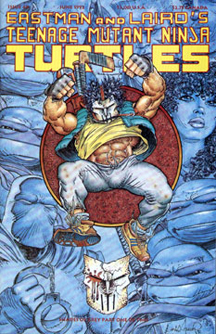It wasn’t just Eastman & Laird’s return to writing duties on Issue 48 of Mirage “Teenage Mutant Ninja Turtles” Volume 1 that got the series back on track after a batch of mediocre-to-poor issues dating back to Issue 27. The mere announcement that they’d be taking back the reins gave all the issues from 41-49 (1991-92) a little extra edge and excitement, from the panels to the letter column.
Issue 41
First, we have one more comedy issue to get out of the way. I like the premise of Matt Howarth’s “Turtle Dreams” (41). Leo imagines being the cool kid at an all-turtle school, Raph imagines kicking some butt (and he continues to sleep peacefully when the fight never ends), Don worries about being experimented on by the government or – worse — becoming fat, Mike fights for his right to rock ‘n’ roll, and Splinter enjoys a meal with Einstein and other philosophers.
The Raph story particularly seems spot-on, but with the other Turtles in serious need of character exploration at this point, this issue is unfortunately more comedic than exploratory. (Perhaps Michael Dooney’s one-shot, “Challenges,” also from 1991, does better. I’ll look at that one in a future post.)

“Teenage Mutant Ninja Turtles” Issues 41-49 (1991-92)
Titles: “Turtle Dreams” (No. 41), “Juliet’s Revenge” (No. 42), “Halls of Lost Legends” (No. 43), “The Violent Underground” (No. 44), “Leatherhead, Too” (No. 45), “Masks, Part 1” (No. 46), “Masks, Part 2” (No. 47), “Shades of Gray” (No. 48), “Ripplings” (No. 49)
Writers: Matt Howarth, Rick McCollum, Bill Anderson, Paul Jenkins, Rick Arthur, Dan Berger, Michael Dooney, Kevin Eastman, Peter Laird, Jim Lawson
Pencils: Matt Howarth, Rick McCollum, Bill Anderson, A.C. Farley, Rick Arthur, Dan Berger, Michael Dooney, Jim Lawson
Inks: Matt Howarth, Rick McCollum, Bill Anderson, A.C. Farley, Rick Arthur, Dan Berger, Keith Aiken
Issue 42
I liked Rick McCollum and Bill Anderson’s Issue 37, and “Juliet’s Revenge” (42) is even better as the Turtles draw the wrath of the powerful time-witch Savanti Juliet, the wife of Savanti Romero, whom the Turtles had (seemingly) killed in “Tales” No. 7. It also re-introduces timestress Renet in her more mature (and, from an artistic perspective, hotter) form.
In a panel where the Turtles are sitting at the kitchen table, you can see a stack of empty pizza boxes atop the fridge, and I believe that’s the first Mirage reference to the gang’s love of pizza (something that was originally invented for the cartoon and then carried into the movie).
Issue 43
I didn’t connect with A.C. Farley’s Issue 29 at all, but I enjoyed “Halls of Lost Legends” (43), which allowed me to appreciate his art without trying to decipher the dense literary allusions. Here, Paul Jenkins provides a tale about the Turtles stumbling upon a place where gods of various Earth lores are retired as frozen statues once people no longer believe in them.

That’s just the starting point of the story; Donatello wisely digs deeper into the mystery. “Thor” fans might enjoy the inclusion of Loki; I was just happy that I didn’t need to understand a ton of outside literature to enjoy this book.
Issue 44
Rick Arthur’s “The Violent Underground” (44) introduces martial arts hobbyist Lucindra, who spars with Raph in the sewers as both of them need time away from their families to work off steam. It’s a harmless issue with good art – and unlike other guest issues, Lucindra doesn’t steal too many pages from our heroes — but because Lucindra didn’t immediately emerge as a major ally the way Casey did, it seems like a path not taken.
E&L playfully note in their introduction: “But honestly, Rick, Raph beaten by a human?” And, indeed, it’s odd that Lucindra seems to totally have Raph’s number in head-to-head combat.
Issue 45
That marked the end of the guest era, and Dan Berger’s “Leatherhead, Too” (45) marked the return to in-house production of “TMNT.” Just as the Lucindra story didn’t lead to much, neither did this Leatherhead yarn – at least not right away.
For immediate story purposes, the important element here is that the Turtles check out their old stomping grounds in NYC (although they don’t move back from Northampton just yet) and discover that – much like the start of the 1990 “TMNT” movie – the city is experiencing a ninja crime wave. Raph realizes: “It seems like we left our mission incomplete. We cured the symptom (by killing the Shredder and blowing up Foot headquarters in Issue 21). Not the whole bug.”
In the A-plot, Leatherhead (living in the Turtles’ old lair since his introduction in “Tales” 6) recruits some Foot soldiers (who are thrilled to have a sensei) to build a transmat device that will send the mutant gator to the Utrom homeworld. When it fails, Leatherhead blames both the Turtles and the Foot and stomps off into the sewers.
Issues 46-47
Michael Dooney’s “Masks” (46 and 47) sends the Turtles – along with time-scepter-wielding Renet, again looking hot – to 1373 Japan. Considering that these issues came out in early 1992, it’s likely that they influenced Stuart Gillard’s script for “TMNT III: The Turtles are Back … In Time,” which came out a year later.
But don’t hold that against it, because Dooney pens a great yarn that incorporates not only the Renet-vs.-Savanti Romero rivalry (he’s not dead after all), but also Hattori, the young Japanese-American whom the Turtles helped way back when they were pre-teens (in Issue 9, a flashback issue).
He’s also the first writer in quite a while to remember that Mike has a pet kitty, Klunk. And what an awesome final-panel twist: The samurai warriors whom the Turtles assist against Savanti are the founders of the Foot Clan – through their time-travel exploits, the Turtles accidentally created their nemeses! It’s “Masks” that really puts “TMNT” back on the confident, rapid-fire storytelling footing we hadn’t seen since “Return to New York.”
Issues 48-49
And then in “Shades of Gray” (48 and 49), Eastman and Laird return to writing duty, with Jim Lawson on pencils. This is a toned-down story that will remind “Buffy” fans of the Season 3 arc where Faith accidentally kills a human. Here, Casey kills a punk in a Springfield park.
Legally, it’s a clear case of self-defense, and Nobody (Springfield’s police officer/Batman-wannabe introduced in “Tales” No. 2) acknowledges this, but notes that Casey seems “guilty as hell.” It’s certainly a hypocritical position from Nobody, who has killed bad guys himself – Raph calls him out on this, noting that Nobody killed “a couple of chopper jockeys” with a rocket launcher in “Tales” 2.
But the main points of “Shades of Gray” are to set the characters up for “City at War” (50-62). Casey hates himself for killing a kid. Will he take the Faith route and turn bad, or perhaps go the opposite direction and lose his edge? After being asked out on a date and talking to her sister on the phone, April wonders what “normal” life would be like. She asks Splinter for advice, and he rudely says “Leave!” Is he trying to make her angry so she will indeed leave her makeshift family, and thus lead a safer life?
We also see that Splinter now allows the Turtles to do their own thing. He suggests training missions but doesn’t force anything on them, and he lets Don stay at the farmstead and work on a science experiment rather than go on the Springfield training mission: “Although you are still my student, Donatello, I must allow you the freedom to find your own path.”
Final thoughts
During the three-year guest era, Mirage’s “TMNT” no doubt lost some fans it would never regain. But judging from the letters pages in these issues, loyal fans were generally excited about the end of the guest era and the return to a steady continuity. (Timing worked out perfectly for me, as “City at War” was starting just as I was outgrowing Archie “TMNT” comics and looking for something deeper.
Of course, I bought all the guest-era issues and was confused by them, but I didn’t have to dwell on them.) Issues 41-49 showed that the Mirage team was paying attention to continuity again by checking in on Leatherhead, Renet, Savanti Romero, Nobody and the Foot Clan – and then the characters’ psyches in “Shades of Gray.” “City at War” promised to ratchet things up even further.

